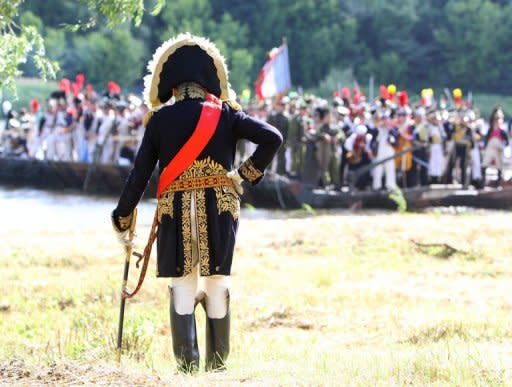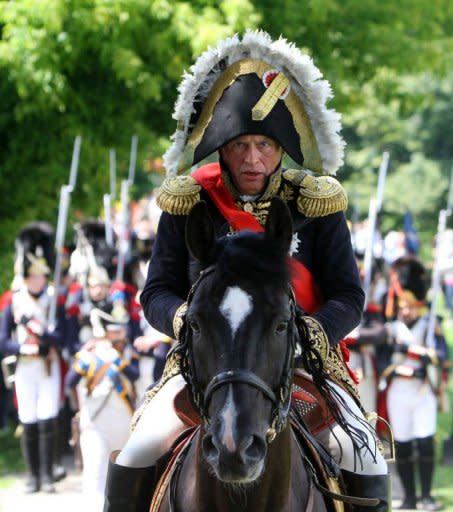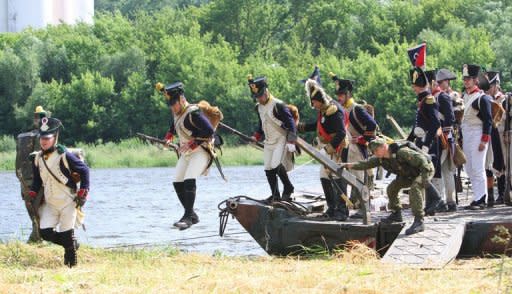Lithuania relives bicentennial of Napoleon's march on Russia
A stubby Napoleon Bonaparte waves his characteristic bicorne hat in an impassioned signal to hundreds of troops, launching a rerun of France's failed invasion of Russia two centuries ago. "Vive la France, vive la Pologne," cries the French emperor on horseback to the enthusiastic cheers of hundreds of troops decked out in 19th-century military garb. The emperor and his troops were poised for action Saturday on the banks of the river Neman in Kaunas, central Lithuania: more than a thousand history buffs re-enacting Bonaparte's June 24, 1812 assault on Tsarist Russia. This time around they were under the command of Oleg Sokolov, a professor in Paris at the Sorbonne University. "Events like this are my life," Sokolov, who is Russian, told AFP, resplendent in a division general's dark blue uniform with a red stripe and golden epaulettes. On his signal, hundreds of weekend warriors crossed the Neman in boats and pontoons, to the hearty applause of thousands of cheering onlookers -- but in the face of thundering salvos from men wielding Russian imperial army weaponry. A blast of rolling thunder from a cannon and clouds of smoke heightened the sense of drama as battle was joined once they reached the shore, the French forces eventually forcing a Russian retreat. "Recreating a battle with cannons, horses and sabres is much more serious stuff than theatre or a movie," Lithuanian history enthusiast Arvydas Pociunas, the Tsarist Russian chief-of-staff for the day, told AFP. "You must keep a sharp eye out every second," he explained. The spectacular re-enactment drew more than 1,000 participants from France, Russia and across the region, including Lithuania, Poland, Belarus, Latvia, Ukraine and the Czech Republic, organisers said. The original Grand Armee that crossed the Neman on the night of June 24, 1812 numbered 220,000. Ahead of Saturday's battle, the troops-for-a-day marched to the pulse of beating drums in a park in Kaunas: red-white-and-blue French flags flew over a hundred white tents that made up the weekend's camp. "It's like an open-air theatre with a great atmosphere," said Belgian tourist Francois Forget, 35, standing among a crowd of enthusiasts, many of whom were wearing Napoleon's characteristic hat. In the camp itself, soldiers were accompanied by ladies dressed in period costume, some sleeping by the fire on piles of hay. "Villagers like us in the camp help to create the spirit of history", museum historian Svetlana Pantchenko, 47, told AFP. She had travelled to Lithuania from the neighbouring Russian enclave of Kaliningrad, alongside her husband Alexander, who proudly wore his green uniform with the Russian imperial double-headed eagle. "Our artillery club includes engineers, teachers, builders, and we all meet in places like this", Pantchenko said. The original crossing of the river Neman -- the Nemunas in Lithuanian -- was Napoleon's first step on what in the end was a doomed march through western Russia. Despite initial successes, the next winter Napoleon suffered a crucial defeat which proved a huge blow for his plans to dominate Europe. For Lithuania, now a Baltic state of three million, the French general's arrival raised hopes that it could break free from imperial Russia. After the 1795 partition of the Polish-Lithuanian Commonwealth by Russia, Prussia and Austria, most of Lithuania was ruled by the Tsar and some saw Napoleon's advance as the opportunity to win freedom. "The arrival of Napoleon army brought a real and tangible hope for Lithuanians the Russian empire could be defeated", Lithuania's Defence Minister Rasa Jukneviciene said in a welcoming address ahead of Saturday's re-enactment. "By losing the battle in Russia, the emperor rushed back to France -- and with him went Lithuania's unfulfilled hopes to restore its lost independence with the help of France", she added.. Lithuania and Poland only reemerged as independent nations after World War I.




